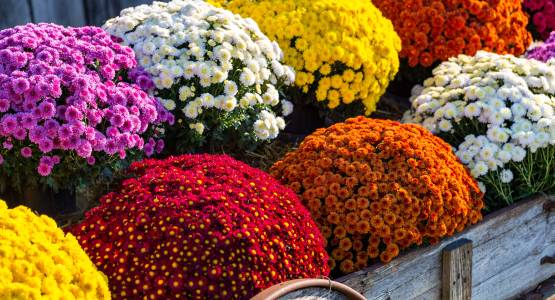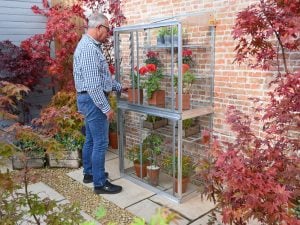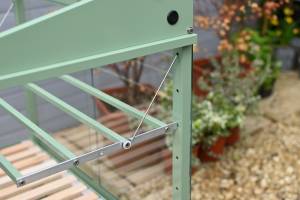What Flowers to grow in a Greenhouse in the Winter

As winter sets in across the UK, many gardeners lament the loss of vibrant blooms and lush foliage in their gardens. However, a greenhouse can provide an excellent environment to continue cultivating beautiful flowers throughout the colder months. By carefully selecting winter-friendly varieties and providing proper care, you can keep your greenhouse thriving even in the chilliest weather. This blog explores the best flowers to grow in a greenhouse in the winter, along with essential tips for planting, maintenance, and deadheading.
Why Grow Flowers in a Greenhouse During Winter?
A greenhouse creates a controlled environment that shields plants from frost, wind, and harsh winter weather. It also allows you to extend the growing season and cultivate a variety of plants that would otherwise struggle outdoors during winter. For many gardeners, a winter greenhouse is an opportunity to enjoy continuous blooms, brighten up dreary days, and experiment with new flower varieties.

Best Flowers to Grow in a Greenhouse in Winter
1. Cyclamen
Cyclamen are popular winter bloomers known for their bright, butterfly-like flowers and attractive marbled foliage. They thrive in cooler temperatures and add a splash of colour to your greenhouse.
- Planting: Cyclamen corms should be planted in well-draining compost, with the top of the corm just above the soil surface.
- Care: Keep the greenhouse temperature between 10-15°C and water sparingly to avoid waterlogging.
- Deadheading: Regularly remove spent flowers and yellowing leaves by twisting them gently at the base.
2. Primroses (Primula)
Primroses are hardy plants that can bloom even in the coldest months, offering a range of colours from vibrant yellows to deep purples.
- Planting: Use a nutrient-rich, well-draining potting mix and ensure the greenhouse has good air circulation.
- Care: Water consistently but avoid overwatering. Provide indirect light and maintain a temperature of 5-10°C.
- Deadheading: Pinch off faded flowers to encourage continuous blooming.
3. Pansies and Violas
These cheerful, resilient flowers can withstand cooler temperatures and brighten up any greenhouse with their wide array of colours.
- Planting: Start with established plants or sow seeds in trays. Use a good-quality potting mix.
- Care: Keep the greenhouse temperature between 7-15°C and water regularly.
- Deadheading: Remove spent blooms to promote new growth.
4. Sweet Peas (Lathyrus odoratus)
Winter-flowering sweet peas provide delicate, fragrant blooms that are a delight for any greenhouse gardener.
- Planting: Sow seeds in deep pots in autumn for winter flowering. Use a rich compost and provide support for climbing varieties.
- Care: Maintain a temperature of around 10°C and ensure the plants have plenty of light.
- Deadheading: Regularly cut flowers to encourage more blooms.
5. Begonias
Tuberous begonias are a stunning addition to winter greenhouses, with their vibrant colours and lush petals.
- Planting: Start tubers in pots with well-draining soil. Position them so that the indented side faces upwards.
- Care: Keep the greenhouse temperature above 10°C and provide indirect light.
- Deadheading: Remove faded flowers and any damaged leaves promptly.

6. Chrysanthemums
Late-flowering chrysanthemums can provide dramatic blooms well into winter. If you are really keen, you can even join a society!
- Planting: Pot chrysanthemums in nutrient-rich compost and position them in bright light.
- Care: Maintain temperatures between 10-15°C and water moderately.
- Deadheading: Snip off spent flowers to extend the blooming period.
Essential Tips for Winter Greenhouse Gardening
1. Temperature Management
Temperature control is critical for successful winter greenhouse gardening. Install a reliable thermostat and consider using a greenhouse heater to maintain consistent temperatures. Many winter-flowering plants prefer cool but frost-free conditions, typically ranging between 5-15°C.
2. Ventilation
Proper air circulation is essential to prevent condensation and fungal diseases. Open vents or windows on mild days to allow fresh air in, but ensure the greenhouse remains warm enough for your plants.
3. Lighting
Shorter days and weaker sunlight in winter can limit photosynthesis. Supplement natural light with grow lights if necessary, particularly for light-loving plants like sweet peas and chrysanthemums.
4. Watering
Watering requirements are lower in winter due to reduced evaporation. Water sparingly but consistently, and always avoid waterlogging. Use tepid water to prevent shocking the roots.
5. Pest Control
While fewer pests are active in winter, you should still monitor your greenhouse regularly. Common issues include aphids and whiteflies. Introduce beneficial insects like ladybirds or use organic pest control methods if infestations occur.
6. Hygiene
Maintain a clean greenhouse environment to reduce the risk of diseases. Remove dead leaves and spent flowers promptly, and disinfect tools and pots regularly.
Deadheading: Why It Matters
Deadheading is the process of removing spent flowers to encourage plants to produce more blooms. This practice is particularly important during winter when light and warmth are limited. By deadheading regularly, you can:
- Redirect the plant’s energy into producing new flowers instead of seeds.
- Prevent fungal infections caused by decaying plant matter.
- Improve the overall appearance of your plants.
To deadhead properly, use clean, sharp scissors or your fingers to pinch off faded blooms just above a leaf node or bud. Be gentle to avoid damaging the plant.
Planning Your Winter Greenhouse
1. Layout and Space
Arrange your plants to maximise light exposure. Taller plants should be placed at the back or sides, with shorter plants at the front. Use shelving or tiered plant stands to optimise space.
2. Composting and Feeding

Winter flowers benefit from slow-release fertilisers or regular feeding with a balanced liquid fertiliser. Incorporate compost into your potting mix to improve soil fertility and structure.
3. Monitoring
Check your plants daily for signs of stress, pests, or disease. Early intervention can prevent minor issues from becoming major problems.
Conclusion
With the right approach, a greenhouse can be a haven for winter blooms, allowing you to enjoy vibrant flowers even in the coldest months. From hardy cyclamen to fragrant sweet peas, there are plenty of options to brighten up your greenhouse and keep your gardening spirit alive through winter. By focusing on proper planting, regular care, and essential maintenance tasks like deadheading, you can create a thriving winter wonderland in your greenhouse.
Whether you’re an experienced gardener or a beginner, winter greenhouse gardening offers a rewarding way to stay connected with nature year-round. So, roll up your sleeves, gather your tools, and transform your greenhouse into a floral paradise this winter!
